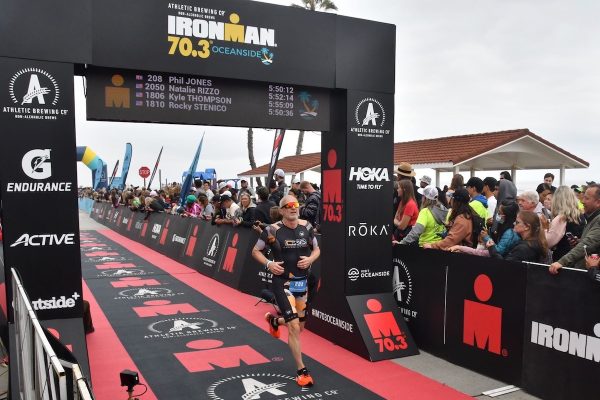
2022 Ironman 70.3 Oceanside Race Report
I did the Ironman 70.3 Oceanside race back in 2019 and had one of those days, where I really struggled. It is such an iconic race however, that I vowed to do it again one day and perform better. My return to the race happened in 2022 and I was able to perform much better this time around. The report below includes a description of the course, my preparation and training, and finally, details of my race. I hope you enjoy it.
Race Logistics And Course Description
Ironman 70.3 Oceanside is a well established race on the North American calendar. It typically kicks off race reason for professional triathletes and so is usually attended by some of the best triathletes in the world. This year was no different with very strong male and female fields. Outside of the bike leg, this race is very spectator friendly. Friends and family members can easily watch the swim start and swim exit. The transition area is located in a parking lot at the harbor, which is about a mile from the finish line near the Oceanside pier. The run is especially good for spectators and you can see athletes at least four times quite easily.
Now that they have put back the ocean into the Oceanside swim, it is a fantastic, if challenging experience. For several years, the swim leg was contained within the harbor, but now it starts with a beach entry. This presents several challenges. The first is getting through the surf. Depending on how high the waves are, this can be tough.
Once through the waves, there are additional factors to consider, as you swim directly out to sea towards the first turn buoy. You have the general chop and swell of the ocean plus a left to right current that drags you off course. The organizers deliberately place the intermediate buoys to the left, so if you aim for them you will drift to the turn buoy with the current. After getting around that first turn buoy, the swim becomes much easier. You swim with the current through the harbor entrance, before making another right turn to enter the harbor proper. It’s then a case of swimming in relatively calm, if crowded, water toward the final turn buoys that take you to the boat ramp and the swim exit.
The run to your bike in transition is long, going around the outside of the fenced off area where the bikes are located. Just before entering transition, you have the opportunity to take advantage of wetsuit strippers, which I always do. Transition is long and thin, so there is a lot more running, either with or without your bike.
The next challenge is the bike course. It is a great course, with significant sections of it within the Marine Corp’s Camp Pendleton. The fact that most of the course is within the camp, means that it is not possible to ride or drive the bike course ahead of time. It therefore helps to study the course map in detail and take advantage of the many descriptions of the course online.
The first thirty miles or so are relatively flat. They offer the opportunity to get up some good speed. This is important because the hills and the windy roads heading back to town will slow you down. During those first thirty miles, there are a couple of sections that are no passing zones. The first of these is when you pass behind the commissary. On this section, the road surface is very rough and there are some significant bumps. It is critical to pay attention to avoid a crash or losing nutrition bottles. The second no pass zone is on the Trestles bike path at about mile 24. Throughout this ride north along the coast, it is necessary to pay attention to the road surface. Some areas are pretty rough and there are potholes, which are clearly marked with orange tape.
Once off the Trestles bike path, you turn inland and re-enter the Marine Corps camp. A few miles later you reach the first of three hills… Hell Hill. You easily see the climb ahead of you as you approach it. The road winds its way up the side of the hill and you see all the cyclists on it. The hill averages about 12% grade and is half a mile long. You will see several athletes off their bike and walking up. It’s a tough climb and I used an 11-32 cassette to help me get up it.
There are two more climbs before mile 41, Mini Hell and Hell Hill Junior. While not easy, they are nowhere near as demanding as Hell Hill. Even though most people talk about going up the hills, you also get to go downhill too. You can get some real speed on these sections, except on a critical downhill section at mile 39. On this descent there is a no passing zone that has a speed limit of 25 mph. You MUST obey the speed limit and no passing rule, otherwise you be disqualified. It is a fast descent so you will find yourself riding the brakes quite hard to stay within the speed limit.
Eventually, you will get to turn right onto Vandergrift Road and head back towards town. This section of road can have a strong headwind. With the ride almost over, you need to just put your head down and go. As you arrive back at transition, you have one more slight challenge to navigate. You need to ride your bike around transition to the far end, where the dismount line is located. The path around transition is the same one that you used coming out of the water; it is narrow and twisty. I have seen people crash in this area both times I have done this race, so be careful.
When reviewing the run course on paper, it appears to be really flat. While not the most challenging course on the Ironman circuit, there are some deceptive rollers. There are also a couple of very steep, but short climbs. The spectator support and views however, more than make up for this. It’s my favorite run course out of any I have done so far.
You leave T2 and run over a bridge into town. At the edge of town you cut down to the Strand, which runs alongside the beach. In the distance you see the pier and you feel the sea breeze; it’s great. Until you reach the pier, the course is pretty flat. At the pier you have the first of three short, steep climbs. The first climb takes you up to street level for a few hundred yards, before descending down another steep section, back onto the Strand. This little diversion takes you around the finish line, which you will pass a couple of times before the end of the run.
Once back on the Strand, you have about half a mile of dead flat running. Again, the beach is right there alongside you, and the palm trees are blowing in the wind. Eventually you turn inland and climb the third steeper incline. Next it is a case of running the streets for about three to four miles, on an out and back. There is no flat on this part of the course; it is all gently rolling. Luckily, there is also plenty of support from spectators, and because it is out and back, you have great chance of seeing friends doing the race.
Before you know it, you are back by the pier and can see the finish line. Unfortunately, you have to make a sharp right and go up to street level again. It’s time to run back to the harbor and complete lap two, of the the two loop run. The second time you run along the Strand from the south, you do get to stay straight. It is time to enter the finish chute and onto the famous red carpet. You will hear your name called and the race is over.

Oceanside Pier
Training Cycle
Every training cycle going into an event is different. With this race being early on the calendar and with living in Pittsburgh, preparing to race is challenged by climate. Winter training in Pittsburgh, for an outdoor race in early April is tough because a lot of that training is indoors. This is particularly challenging for cycling, as it was only in the final two weeks before the race, that I could ride my bike outdoors. Luckily, that was enough for me to become confident in my bike handling skills again.
Fortunately, I had a really good training cycle and was able to stay injury free. I was able to build a very solid base by working hard through December and January. This base proved to be very valuable as it meant that my preparation for the race was not significantly impacted, when I went on vacation to England for two weeks in early February.
Upon my return from England, I had time for a four week block of solid training, before tapering for the race. In that four week block, I averaged over 14 hours of training per week. A typical week included three swims, four bike sessions and five runs. The training went extremely well and the only workout I missed was a single swim, which I couldn’t do because my pool was unexpectedly closed that day.
Another thing about this training block that was different to previous big blocks, was that I didn’t feel completely fatigued at any time. The biggest benefit of my retirement from work last year, has been my ability to focus on rest and recovery. Not having the stress of going to work every day, has allowed me the time to recover from workouts effectively. It has made a huge difference.
As I entered taper, two weeks ahead of my race, I was feeling really good. It was now time to focus on staying sharp and using my extra time to prepare travel to southern California.
We arrived in Oceanside late on the Wednesday of race week. This gave me plenty of time to recover from the travel, rebuild and test out my bike and relax a little ahead of the race on the Saturday.
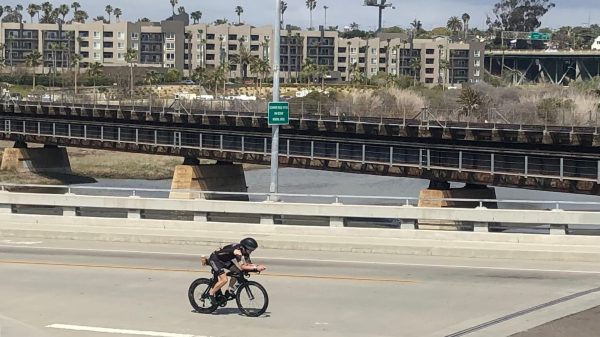
Pre-Race Ride – This Is The Bridge From The Harbor Into Town (Part Of The Run Course)
My Ironman 70.3 Oceanside Race
Race Morning
My wife and I were staying at a condo that was within easy walking distance of transition. This made race morning logistics really simple for us. After my usual pre-race breakfast and coffee, we grabbed the bags I had packed the day before and walked over to transition.
My spot in transition was only one rack away from where the professional triathletes were racking their bikes. I got to see pretty much all of the loaded field setting up for their races. At my bike, I loaded up my nutrition and put my bike computer in its place on my extensions. I borrowed a pump from a neighboring athlete and put the requisite amount of air into my tires. Finally, I set up the rest of my things on a small towel next to my bike. Run gear towards the rear and bike gear at the front. The bike gear included my bib number. This race is unusual because you have to wear your race bib number on the bike leg; the Marine Corps require it, for you to be on base.
With everything all set, I left transition to find my wife at a pre-arranged spot. After relaxing for a few minutes and making a bathroom visit, it was time to put on my wetsuit and go for my warm up swim. It was great to get into the ocean for a brief swim. So much better than just waiting around and only getting into the water after the race has started. As I was leaving the water, I heard the canon sound to signify the start of the men’s professional race. It was time to take my spot in line at the swim start.
When I got to the corral for the swim start, I realized I had made a slight judgement error. The corral was so crowded that I couldn’t make my way forward to seed myself appropriately by time. I had wanted to enter with swimmers looking to finish in around 40 minutes. Unfortunately, I was stuck in the 47-50 minute wave. There was nothing I could do about it, so I chose to let it go and not stress out. It was hardly a disaster.
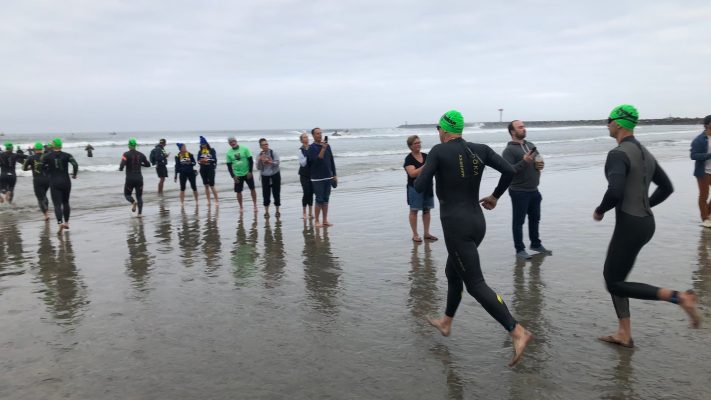
Heading Into The Surf At The Swim Start
The Swim
The start of Ironman 70.3 Oceanside was the typical wave start used by Ironman for age- groupers. Groups of five athletes were set off every five seconds. When my time came, the beep sounded and I ran towards the ocean. I was determined to stay calm and gradually work my way through the surf to the open ocean.
I was able to wade and dolphin dive quite a way out. Eventually however, the waves were over head height and it was time to swim. The waves were quite big, but not as bad as when I did this race in 2019. Getting through the surf was a bit of a blur, with the constant diving under the breakers and then swimming quickly before the next one hit. I must have done quite well, because I don’t remember getting rolled by any waves, and before I knew it I was past them.
I was a little gassed from getting past the waves, so started swimming towards the first yellow buoy quite slowly. During this part of the swim, I really struggled to get into a good swim rhythm. I am not sure if it was my heavy breathing or the chop of the ocean that caused it. I was also surrounded by a lot of swimmers and so was sighting about every other stroke. This didn’t help when it came to getting settled down. Nonetheless, I kept moving forward and eventually made it to the red turn buoy.
Once around the first turn buoy, things started to improve. I deliberately moved to the side a little, so as to get out of the crowds and find a rhythm. This worked and with the help of the current in the ocean, I was soon turning into the harbor.
By now I was swimming well and subsequently faced another challenge. I was swimming much faster than many of the people around me. This is where getting caught in the wrong seeding area hindered my progress. I was bumping into people all the time and constantly changing direction slightly to avoid collisions. That harbor swim was the most crowded swim that I have ever done.
Despite the crowds and the challenge of avoiding people, I was now enjoying the swim and could see the swim exit. I picked up my pace a little as the thought of leaving the water crossed my mind. The crowds condensed towards the very end of the swim and as I left the water, we were running up the boat ramp, three or four athletes at a time.
I made the very long run into transition, stopped to at the wetsuit strippers to get out of my wetsuit and headed towards my bike. I remember thinking that I had managed a decent swim, but also thinking that I probably lost a few minutes struggling to get into a rhythm. It was only as I saw my wife when leaving T1 did I learn that this was by far my fastest 70.3 swim; almost four minutes faster than my previous quickest at Ironman 70.3 Musselman.
Swim Time : 0:39:49
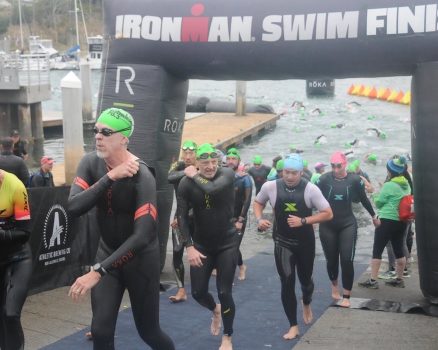
A Very Crowded Swim Exit
T1
With my wetsuit over my shoulder, I ran the whole length of transition to my bike. Many of the bikes around my spot had already left, so I had plenty of room as I quickly put on my bike gear. I gulped down a gel to try and get a good start with my nutrition, turned on my bike computer and then grabbed my bike off the rack.
My run to the mount line was short. I did my usual thing of running well past the mount line and off to one side, so as to avoid the chaos of other riders getting on their bikes. As I was mounting my bike, I heard a familiar voice. It was my wife and she was screaming about how good my swim was. I asked her “how fast?” and when she told me “under forty minutes”, I said “you are joking right?”. Obviously she wasn’t.
I got on my bike and headed towards the harbor exit. It was then that I realized that the visor on my helmet was still in its storage position and not in front of my face… rookie mistake. I was faced with choosing to either try and put it in place while riding or stopping and quickly fixing it. I chose the latter; there was no point risking a bike wreck just to save a few seconds.
T1 Time : 0:07:12

Climbing The Hill Coming Out Of The Harbor At The Start Of The Bike Leg
The Bike
Coming out of the harbor area is a short climb, before the course winds it way in and out of the Marine Corps base and north along the coast. I climbed the hill well and soon settled down into my aero position. I was determined to stick with my nutrition plan. That plan was to try and get in most of my nutrition within the first thirty miles of the bike, before we starting climbing the hills. I immediately started downing my nutrition drinks. The feeling of lots of nutrition in my stomach was not great, but certainly manageable and I did follow my plan.
What was not going to plan was how my legs were feeling. They were OK but were not feeling strong. I just couldn’t push the power that I was hoping to. From about mile ten onwards, my legs continued to feel weak, so I told myself to not push super hard and save my energy for the run.
As I made my way along the coast, I was still making good time. I was averaging over 20 mph and thinking to myself that a great run would mean a great race. I could live with a slightly below par bike leg, as long as my run was good. This attitude carried all the way to the hills.
The views of Hell Hill are great as you approach it. You see the road winding its way up the hill and also see hundreds of cyclist making their way up the hills. It is like a line of ants climbing a hillside. I was confident in my ability to climb the hills and that turned out to be valid. I passed a lot of cyclists on the hill, including many who were walking their bikes to the top. Once over the top, I really enjoyed the downhill portions, as I powered my way forward at over 40mph.
I continued to ride somewhat conservatively for the rest of the ride, saving myself for the run. I climbed the remaining hills well, bombed the downhills and focused on getting low on the windy flats back into town. By now I was almost all of the way through my nutrition and looking forward to the run. I had no idea if my legs would hold up, but I had given them every chance to succeed, by being smart on the bike.
Heading back into the harbor, I started to focus my mind on digging deep on the run. I was deep in thought as I rode along the very narrow path around transition. Suddenly, the bike in front of me clipped a fence post and crashed to the ground. Luckily, instincts kicked in and was able to brake and quickly unclip. I checked on the person who crashed and he said he was fine. I clipped back in and rode to the dismount line a few hundred feet away.
Bike Time : 2:55:15
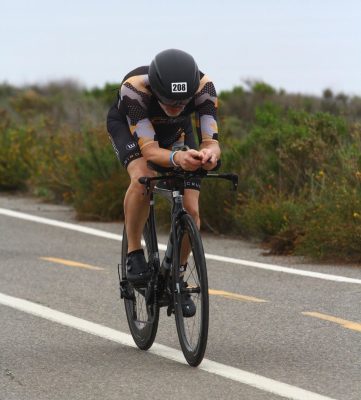
Head Down On The Trestles Bike Path Section Of the Bike Leg
T2
T2 was uneventful, which is always a good thing. It was a long run to my bike in my bike shoes, which got me thinking about maybe leaving them on the bike at my next race. Still I got to my bike slot in good time and was quickly into my run shoes. I grabbed a drink and my banana and headed out to the run course.
T2 Time : 0:05:42
The Run
So now it was time for the key part of my race. Would my legs be in good enough shape to allow me to compete, or would I be destine to focus on completing the race? Within half a mile, I knew the answer. My legs were dead.
To be honest, I was not surprised. My legs didn’t feel right on the bike, so when they felt the same as I headed towards town, I accepted my fate and made new plans. My new goal was to run the whole course, even if my pace was not what I wanted it to be. I would walk briefly at aid stations and maybe up those super steep inclines, near the pier. I was able to execute this new plan well.
The good thing about this race is that even if your run isn’t going fantastically well, the views and the crowds make up for it. Running on the Strand is great; the fact that it is dead flat helps. I saw my wife a couple of times as I ran the course and also ran into a teammate who gave me some very encouraging words.
My plan to walk in aid stations worked well. I chose to run all the way to the far end of each station and grab what I needed there. This meant that I minimized the time I was walking. If I had started walking as soon as I got to the station, I would have walked all the way through, wasting quite a bit of time.
The run was a bit of a grind. Running on tired and dead legs is tough mentally, especially when you know that you can run a lot better. I was kind of dreading the second loop of the course, but it actually went by quite quickly. It was not the total strugglefest I feared.
As the finish line came into view, I got the inevitable boost from seeing the red carpet and picked up my pace slightly. I crossed the line smiling. It was not the really fast race I had hoped for, but it was still much better than the one I did in 2019. I had my redemption; I was forty minutes quicker than my previous disappointing race.
Run Time : 2:02:15
Overall Time : 5:50:12 (33rd in age group)

Reaching The Red Carpet Is Always A Reason To Smile
Post-Race and Lessons Learned
Having crossed the line, I got my medal and finisher cap and headed off to find my wife. The finish area was super crowded so it took a while. I had managed to grab a Coke and some chips while looking for her, but chose to avoid the huge line for the other post race food. The food looked really good, but I estimated it would take me about thirty minutes to get some.
I eventually caught a glimpse of my wife waving frantically to capture my attention. I gave her a big hug and once again thanked her for being a fantastic sherpa. We decided to leave the crowds behind and made our way to our condo. To get to our condo, we walked along the Strand, which enabled us to cheer on athletes who were still on the course. It felt good to do that.
Looking back on the race after a few weeks, what lessons did I learn at Ironman 70.3 Oceanside?
I think one of the biggest lessons is to be a little better prepared before the race starts. I need to ensure that I can seed myself appropriately for the swim. My swim has improved to the point where I need to swim with faster swimmers and get out onto the bike course ahead of the crowds.
I also think I am going to experiment a little with race nutrition. The all liquid diet on the bike is not sitting well on my stomach, so I will start to look at including gels or other non-liquid items. I will keep the banana coming out of T2; that is working really well for me.
The big question is… what happened to my legs? I still don’t really know. Perhaps it was just one of those days. Maybe it was all the travel and lack of movement on the plane rides. Should I have included more massage and rolling during taper, to stop my muscles stiffening up. I don’t know the answer, but I will be playing close attention to how my legs feel ahead of my next race.
